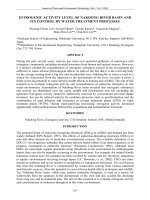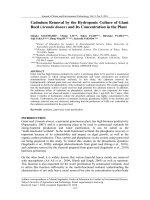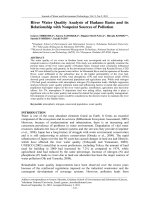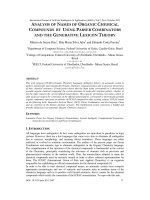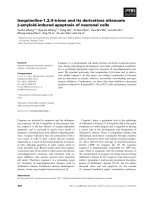methane and its derivatives (chemical industries) by sunggyu lee
Bạn đang xem bản rút gọn của tài liệu. Xem và tải ngay bản đầy đủ của tài liệu tại đây (39.83 MB, 469 trang )
Document
1 of 1 3/1/2007 12:06 AM
Methane and Its Derivatives
Start of Citation[PU]Marcel Dekker, Inc.[/PU][DP]1997[/DP]End of Citation
Document
1 of 2 3/1/2007 12:06 AM
CHEMICAL INDUSTRIES
A Series of Reference Books and Textbooks
Consulting Editor
HEINZ HEINEMANN
1. Fluid Catalytic Cracking with Zeolite Catalysts,
Paul B. Venuto and E. Thomas Habib, Jr.
2. Ethylene: Keystone to the Petrochemical Industry,
Ludwig Kniel, Olaf Winter, and Karl Stork
3. The Chemistry and Technology of Petroleum,
James G. Speight
4. The Desulfurization of Heavy Oils and Residua,
James G. Speight
5. Catalysis of Organic Reactions,
edited by William R. Moser
6. Acetylene–Based Chemicals from Coal and Other Natural Resources,
Robert J. Tedeschi
7. Chemically Resistant Masonry,
Walter Lee Sheppard, Jr.
8. Compressors and Expanders: Selection and Application for the Process Industry,
Heinz P. Bloch, Joseph A. Cameron, Frank M. Danowski, Jr., Ralph James, Jr., Judson S.
Swearingen, and Marilyn E. Weightman
9. Metering Pumps: Selection and Application,
James P. Poynton
10. Hydrocarbons from Methanol,
Clarence D. Chang
11. Form Flotation: Theory and Applications,
Ann N. Clarke and David J. Wilson
12. The Chemistry and Technology of Coal,
James G. Speight
13. Pneumatic and Hydraulic Conveying of Solids,
O. A. Williams
14. Catalyst Manufacture: Laboratory and Commercial Preparations,
Alvin B. Stiles
Document
2 of 2 3/1/2007 12:06 AM
15. Characterization of Heterogeneous Catalysts,
edited by Francis Delannay
16. BASIC Programs for Chemical Engineering Design,
James H. Weber
17. Catalyst Poisoning,
L. Louis Hegedus and Robert W. McCabe
18. Catalysis of Organic Reactions,
edited by John R. Kosak
19. Adsorption Technology: A Step–by–Step Approach to Process Evaluation and Application,
edited by Frank L. Slejko
20. Deactivation and Poisoning of Catalysts,
edited by Jacques Oudar and Henry Wise
21. Catalysis and Surface Science: Developments in Chemicals from Methanol, Hydrotreating of
Hydrocarbons, Catalyst Preparation, Monomers and Polymers, Photocatalysis and Photovoltaics,
edited by Heinz Heinemann and Gabor A. Somorjai
Start of Citation[PU]Marcel Dekker, Inc.[/PU][DP]1997[/DP]End of Citation
Document
1 of 2 3/1/2007 12:07 AM
22. Catalysis of Organic Reactions,
edited by Robert L. Augustine
23. Modern Control Techniques for the Processing Industries,
T. H. Tsai, J. W. Lane, and C. S. Lin
24. Temperature–Programmed Reduction for Solid Materials Characterization,
Alan Jones and Brian McNichol
25. Catalytic Cracking: Catalysts, Chemistry, and Kinetics,
Bohdan W. Wojciechowski and Avelino Corma
26. Chemical Reaction and Reactor Engineering,
edited by J. J. Carberry and A. Varma
27. Filtration: Principles and Practices, Second Edition,
edited by Michael J. Matteson and Clyde Orr
28. Corrosion Mechanisms,
edited by Florian Mansfeld
29. Catalysis and Surface Properties of Liquid Metals and Alloys,
Yoshisada Ogino
30. Catalyst Deactivation,
edited by Eugene E. Petersen and Alexis T. Bell
31. Hydrogen Effects in Catalysis: Fundamentals and Practical Applications,
edited by Zoltán Paál and P. G. Menon
32. Flow Management for Engineers and Scientists,
Nicholas P. Cheremisinoff and Paul N. Cheremisinoff
33. Catalysis of Organic Reactions,
edited by Paul N. Rylander, Harold Greenfield, and Robert L. Augustine
34. Powder and Bulk Solids Handling Processes: Instrumentation and Control,
Koichi linoya, Hiroaki Masuda, and Kinnosuke Watanabe
35. Reverse Osmosis Technology: Applications for High–Purity–Water Production,
edited by Bipin S. Parekh
36. Shape Selective Catalysis in Industrial Applications,
N. Y. Chen, William E. Garwood, and Frank G. Dwyer
37. Alpha Olefins Applications Handbook,
edited by George R. Lappin and Joseph L. Sauer
Document
2 of 2 3/1/2007 12:07 AM
38. Process Modeling and Control in Chemical Industries,
edited by Kaddour Najim
39. Clathrate Hydrates of Natural Gases,
E. Dendy Sloan, Jr.
40. Catalysis of Organic Reactions,
edited by Dale W. Blackburn
41. Fuel Science and Technology Handbook,
edited by James G. Speight
42. Octane–Enhancing Zeolitic FCC Catalysts,
Julius Scherzer
43. Oxygen in Catalysis,
Adam Bielanski and Jerzy Haber
44. The Chemistry and Technology of Petroleum: Second Edition, Revised and Expanded,
James G. Speight
45. Industrial Drying Equipment: Selection and Application,
C. M. van't Land
46. Novel Production Methods for Ethylene, Light Hydrocarbons, and Aromatics,
edited by Lyle F. Albright, Billy L. Crynes, and Siegfried Nowak
47. Catalysis of Organic Reactions,
edited by William E. Pascoe
Start of Citation[PU]Marcel Dekker, Inc.[/PU][DP]1997[/DP]End of Citation
Document
1 of 2 3/1/2007 12:08 AM
48. Synthetic Lubricants and High–Performance Functional Fluids,
edited by Ronald L. Shubkin
49. Acetic Acid and Its Derivatives,
edited by Victor H. Agreda and Joseph R. Zoeller
50. Properties and Applications of Perovskite–Type Oxides,
edited by L. G. Tejuca and J. L. G. Fierro
51. Computer–Aided Design of Catalysts,
edited by E. Robert Becker and Carmo J. Pereira
52. Models for Thermodynamic and Phase Equilibria Calculations,
edited by Stanley I. Sandler
53. Catalysis of Organic Reactions,
edited by John R. Kosak and Thomas A. Johnson
54. Composition and Analysis of Heavy Petroleum Fractions,
Klaus H. Altgelt and Mieczyslaw M. Boduszynski
55. NMR Techniques in Catalysis,
edited by Alexis T. Bell and Alexander Pines
56. Upgrading Petroleum Residues and Heavy Oils,
Murray R. Gray
57. Methanol Production and Use,
edited by Wu–Hsun Cheng and Harold H. Kung
58. Catalytic Hydroprocessing of Petroleum and Distillates,
edited by Michael C. Oballah and Stuart S. Shih
59. The Chemistry and Technology of Coal: Second Edition, Revised and Expanded,
James G. Speight
60. Lubricant Base Oil and Wax Processing,
Avilino Sequeira, Jr.
61. Catalytic Naphtha Reforming: Science and Technology,
edited by George J. Antos, Abdullah M. Aitani, and José M. Parera
62. Catalysis of Organic Reactions,
edited by Mike G. Scaros and Michael L. Prunier
63. Catalyst Manufacture,
Alvin B. Stiles and Theodore A. Koch
Document
2 of 2 3/1/2007 12:08 AM
64. Handbook of Grignard Reagents,
edited by Gary S. Silverman and Philip E. Rakita
65. Shape Selective Catalysis in Industrial Applications: Second Edition, Revised and Expanded,
N. Y. Chen, William E. Garwood, and Francis G. Dwyer
66. Hydrocracking Science and Technology,
Julius Scherzer and A. J. Gruia
67. Hydrotreating Technology for Pollution Control: Catalysts, Catalysis, and Processes,
edited by Mario L. Occelli and Russell Chianelli
68. Catalysis of Organic Reactions,
edited by Russell E. Malz, Jr.
69. Synthesis of Porous Materials: Zeolites, Clays, and Nanostructures,
edited by Mario L. Occelli and Henri Kessler
70. Methane and Its Derivatives,
Sunggyu Lee
ADDITIONAL VOLUMES IN PREPARATION
Start of Citation[PU]Marcel Dekker, Inc.[/PU][DP]1997[/DP]End of Citation
Document
1 of 1 3/1/2007 12:08 AM
Page i
Methane and Its Derivatives
Sunggyu Lee
The University of Akron
Akron, Ohio
Start of Citation[PU]Marcel Dekker, Inc.[/PU][DP]1997[/DP]End of Citation
Document
1 of 1 3/1/2007 12:10 AM
Page ii
ISBN: 0–8247–9754–X
The publisher offers discounts on this book when ordered in bulk quantities. For more information,
write to Special Sales/Professional Marketing at the address below.
This book is printed on acid–free paper.
Copyright © 1997 by MARCEL DEKKER, INC. All Rights Reserved.
Neither this book nor any part may be reproduced or transmitted in any form or by any means,
electronic or mechanical, including photocopying, microfilming, and recording, or by any information
storage and retrieval system, without permission in writing from the publisher.
MARCEL DEKKER, INC.
270 Madison Avenue, New York, New York 10016
Current printing (last digit):
10 9 8 7 6 5 4 3 2 1
PRINTED IN THE UNITED STATES OF AMERICA
Start of Citation[PU]Marcel Dekker, Inc.[/PU][DP]1997[/DP]End of Citation
Document
1 of 1 3/1/2007 12:11 AM
Page iii
Preface
In recent years there has been a considerable increase in research and development in the area of
environmentally acceptable alternative fuels as well as the use of alternative feedstocks as building
blocks for applied chemicals and petrochemicals. Conventional process industries are also faced with
stricter emission control requirements. This trend is going to intensify for the next several decades
because of the dwindling supply of petroleum reserves, emphasis on environmentally safe chemical
technologies, fierce competitiveness in the global petrochemical market, and new discoveries of
high–reserve gas wells and gas hydrates. Among all fossil fuels, natural gas generates the least carbon
dioxide, a major greenhouse chemical, upon combustion. The utilization of natural gas could therefore
help solve the greenhouse–effect problems, even though methane itself is also considered a greenhouse
gas.
More and more books, monographs, and research articles in this area are currently being published,
and most of them are narrowly focused, often emphasizing fine details (e.g., those of kinetic
mechanisms, bench–scale experimental results, analytical procedures, and process hardware).
Furthermore, many of the books are edited, thus lacking consistency and completeness. Researchers,
students, professors, and field engineers need a comprehensive textbook covering the entire topic and
presenting an overview of the subject, from the viewpoints of process chemistry and engineering. This
single–authored book is designed to fill this need.
This book aims at presenting all the scientific and technological information regarding methane and its
derivatives, and at providing an overview of the petrochemical industries that are (or could be) based
on methane or natural
Start of Citation[PU]Marcel Dekker, Inc.[/PU][DP]1997[/DP]End of Citation
Document
1 of 1 3/1/2007 12:11 AM
Page iv
gas. Special attention has been given to the methane derivatives and their commercial exploitation.
Therefore, the coverage follows the tree structure of chemicals, not industries. Some distinctions have
been made among the key building blocks, other building blocks, first–level derivatives, secondary
derivatives, etc. Process chemistry, synthesis technology, historical developments, material properties,
and market trends for each major chemical are discussed in detail and are compared with other
alternatives. Because of their growing significance and close relationship with energy conversion,
environmental issues related to process technology are addressed whenever applicable. Essential
aspects of thermodynamics and process data as well as recent advances in process technology are also
presented.
Engineers and scientists working in fuel science and engineering and specialty chemicals, particularly
in methane and its derivatives, will find this to be useful as a reference. This book also compiles a
great deal of information and data, yet condensed into a concise volume that will be very convenient
for researchers as well as students. It is also a good reference text for professors.
This book can be used as a textbook for a three credit–hour course on methane chemistry, methane
and ammonia technology, or natural gas engineering. It may be used for a more general course in fuel
engineering, gas and coal technology, or alternative energy and feedstocks, or as a reference text for
engineering design courses or chemistry electives. The background required of a reader is an
understanding of organic chemistry at the college level. For scientists and engineers in the energy and
chemical industries, this book will serve as a one–volume comprehensive reference providing
necessary information on process chemistry, manufacturing technology, alternative routes, market
trends, and environmental issues.
Even though quite a bit of effort was called for to develop a book of this nature, the encouragement
and assistance that I received from various people made the work enjoyable. I would like first of all to
thank my wife, Kyung, for her constant support and love while writing this book. I would also like to
thank my children for the countless little things that mean a lot.
The comments and suggestions made by my colleagues at the university and at the American Institute
of Chemical Engineers, Fuels and Petrochemicals Division, have been a great help in putting together
the various parts of this book. The support and encouragement provided by the late Robert Iredell's
family made this work possible and are greatly appreciated.
Last but not least, I wish to acknowledge the direct and indirect help in the compiling of the scientific
and technical information by Mr. Brian S. Kocher, Mr. Timothy I. Tartamella, Mrs. Medha Joshi, Mr.
Mark Brundage, Mr. Ben Lopez, Mr. Cher–Dip Tan, Mr. Ramesh Rachapudi, Mr. Sanjay Shah, Mr.
Abhay Sardesai, Mr. J. David Tucker, Mr. H. Bryan Lanterman, Dr. Kathy
Start of Citation[PU]Marcel Dekker, Inc.[/PU][DP]1997[/DP]End of Citation
Document
1 of 1 3/1/2007 12:13 AM
Page v
L. Fullerton, and Dr. Teresa J. Cutright. I would also like to thank Ms. Jeanine L. Gray and Mrs.
Maria Peters for editing and assembling the manuscript. Without their contribution, this book would
have not been possible.
SUNGGYU LEE
Start of Citation[PU]Marcel Dekker, Inc.[/PU][DP]1997[/DP]End of Citation
Document
1 of 2 3/1/2007 12:22 AM
Page vii
Contents
Preface iii
1. Sources and Availability of Methane 1
I. Energy Overview 1
II. Crude Oil Reserves 8
III. Supplies of Natural Gas in the United States 9
IV. Methane from Natural Gas 17
V. Vertical and Horizontal Integration of Petrochemical Industries 19
VI. Biomass Conversion to Methane 20
2. Synthesis Gas 23
I. Synthesis Gas: Past and Future 23
II. Methane Reforming 24
III. Synthesis Gas via Nonmethane Routes 51
3. Methane Derivatives via Synthesis Gas 73
I. Ammonia 73
II. Methanol and Derivatives 116
III. Oxochemicals 182
IV. Phosgene and Derivatives 190
Document
2 of 2 3/1/2007 12:22 AM
V. Pure Hydrogen 236
Start of Citation[PU]Marcel Dekker, Inc.[/PU][DP]1997[/DP]End of Citation
Document
1 of 2 3/1/2007 12:42 AM
Page viii
4. Methane Derivatives Directly from Methane 263
I. Hydrogen Cyanide 263
II. Carbon Disulfide 280
III. Halogenated Methanes 288
IV. Direct Conversion of Methane to Methanol 293
V. Pyrolysis of Methane 294
VI. Pure Hydrogen by Steam Reforming of Methane 299
5. Natural Gas Engineering 311
I. Transportation of Natural Gas 311
II. Multiphase Behavior in Gas and Oil Systems 314
III. Advances in Gas Treatment 317
IV. Cryogenic Gas Processing 321
V. Unconventional Gas Recovery 326
VI. Storage and Peak–shaving 330
VII. Natural Gas Fuel Cell 333
VIII. Membrane Gas Separation 335
IX. NO
X
and SO
x
Removal 338
X. Sour Gas Processing 341
XI. Natural Gas Vehicles 344
Document
2 of 2 3/1/2007 12:42 AM
XII. Hydrates 346
XIII. Safety and Flammability 355
6. Environmental Issues of Methane Conversion Technology 361
I. Methane Conversion Technologies 361
II. Environmental Issues Related to Methane Conversion
Technologies
375
III. Regulation and Pollution Control 389
Index 401
Start of Citation[PU]Marcel Dekker, Inc.[/PU][DP]1997[/DP]End of Citation

